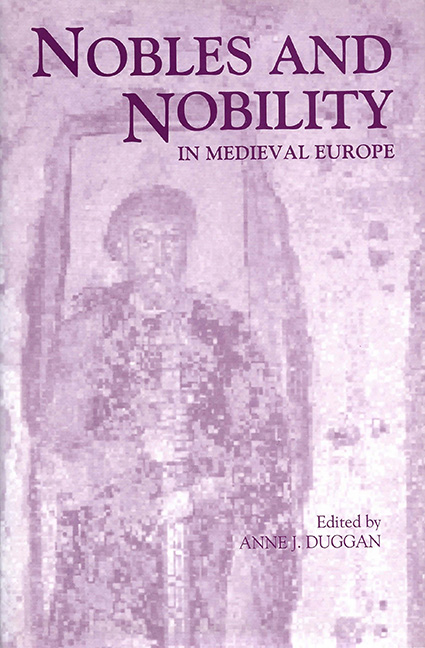 Nobles and Nobility in Medieval Europe
Nobles and Nobility in Medieval Europe Book contents
- Frontmatter
- Contents
- List of Illustrations
- Contributors
- Abbreviations
- Preface
- Dedication
- Introduction: Concepts, Origins, Transformations
- I Early Middle Ages
- 1 The Origins of the Nobility in Francia
- 2 The Nearly Men: Boso of Vienne and Arnulf of Bavaria
- 3 Nobility in the Ninth Century
- 4 Continuity and Change in the Tenth-Century Nobility
- 5 The Old English Vocabulary of Nobility
- 6 Nobles and Others: The Social and Cultural Expression of Power Relations in the Middle Ages
- II Central Middle Ages
- III Late Middle Ages
- Index
4 - Continuity and Change in the Tenth-Century Nobility
from I - Early Middle Ages
Published online by Cambridge University Press: 25 October 2017
- Frontmatter
- Contents
- List of Illustrations
- Contributors
- Abbreviations
- Preface
- Dedication
- Introduction: Concepts, Origins, Transformations
- I Early Middle Ages
- 1 The Origins of the Nobility in Francia
- 2 The Nearly Men: Boso of Vienne and Arnulf of Bavaria
- 3 Nobility in the Ninth Century
- 4 Continuity and Change in the Tenth-Century Nobility
- 5 The Old English Vocabulary of Nobility
- 6 Nobles and Others: The Social and Cultural Expression of Power Relations in the Middle Ages
- II Central Middle Ages
- III Late Middle Ages
- Index
Summary
‘As far back as the memory of man can go, the ancestors of his ancestors were all most noble. There was not one who was unknown as far as his family went, there was not one who could easily be found unworthy of his line. But he surpassed all the rest, apart from the excellence of emperors and kings, in the glory of his talents and in all kinds of intellectual qualities.’ Thus Ruotger described the lofty nobility of Bruno, brother of Otto I. That nobility was rooted in the past, but expressed itself in the present through the radiance of the imperial family and the personal qualities of the archbishop. There was no change, then, in the way the tenth-century nobility represented itself. Illustrious ancestors, a noble family, kin, and friends, social recognition, and personal freedom: these were what made a noble in the seventh century as in the tenth. Those were the constants. Yet the political and social context changed in the tenth century. The weakening of royal power, the growth of the principalities, the establishment of a world of castles, all transformed the ways in which power was exercised, and had profound effects on the ruling class. An attempt to assess factors of continuity and factors of change is therefore timely. This is no easy task; however, for the tenth century continues to pose serious problems for modern historians. I shall not go into the debates over the mutation of the year 1000. Instead, I shall address three urgent questions concerning the political and social changes of the tenth century: first, that of the relations between kingship and nobility, second, the transformation of kinship networks, and third, the emergence of the militia.
Kingship and nobility
Continuities are especially strong in the realm of representation, that is, in ideology. The social order instituted by God at the beginning of time was founded on respect for hierarchy, status, and social distinction. It implied and justified the domination of the noblest over the mass of the population. As in earlier times, nobles continued to base their social, political, and economic pre-eminence on birth, illustrious ancestry, and public service. These nobles constituted the Frankish populus exalted by the legislators of Pippin III as a Chosen People in the new Prologue to the Lex Salica, composed c. 763–764.
- Type
- Chapter
- Information
- Nobles and Nobility in Medieval EuropeConcepts, Origins, Transformations (King's College London 1998), pp. 53 - 68Publisher: Boydell & BrewerPrint publication year: 2000


